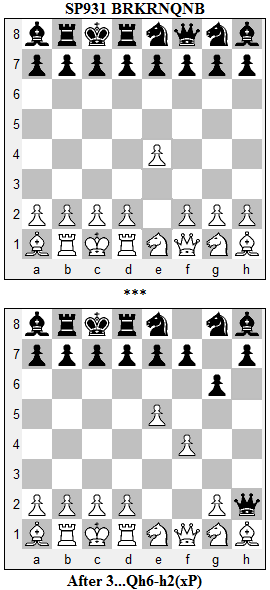The most pronounced characteristics of the position are the Bishops in the corners and the compact Rook-King-Rook formation. I once discussed the Bishop formation in a post Four Cornered Bishops. White's first move 1.e4 blocks the long a8-h1 diagonal, so the light squared Bishop can be developed without being exchanged immediately.
Black has a choice of initial responses, starting with the advance of the b- or g-Pawns either one or two squares. I always find this choice difficult to make. In the current position, it's worth noting that the Queenside Bishop (a-side for the purists) is protected, while the Kingside Bishop isn't. If Black doesn't advance the g-Pawn immediately, White can advance the b-Pawn on the second move, rendering the Black g-Pawn immobile for the near future. That might be why Black chose 1...g6. The advance of the e-Pawn one or two squares was another option.
White continued 2.f4, grabbing another piece of the center and preparing to develop one of the Knights to f3. Black noticed that the h-Pawns are unprotected and played 2...Qh6, attacking the Pawn on h2. If White defends with a Knight to f3, the f-Pawn is left en prise to the Black Queen. I don't like the move 2...Qh6, and would have given more consideration to 2...b6 and 2...b5. That choice illustrates a common tradeoff: the move 2...b6 preserves the option to castle O-O-O, but is more passive than the aggressive 2...b5, which itself has the disadvantage of rendering ...O-O-O problematic. Since ...O-O-O is already awkward because of the Rook on d8, it might be better to plan for an eventual ...O-O, by playing 2...b5.
Now White played 3.e5, taking the squares d6 and f6 from the Black Knights, and daring Black to capture the h-Pawn. This is exactly what happened with 3...Qxh2, bringing us to the second diagram.

Although Black has an extra Pawn, the Black Queen is separated from its own forces and doesn't have an easy path back to them. White answered 4.Ne2, protecting both the f-Pawn and the Bishop on h1. The game continued 4...b6 5.b4 f5, where Black's last move is very hard to understand, since it develops nothing. Was Black trying to prepare protection for the Queen on g4?
Black's position was further weakened after 6.Nf3 (attacking the Queen) 6...Bxf3. The exchange of the Bishop for the Knight defends the Queen, but seriously weakens the light squares on Black's Queenside. After 7.Qxf3, Black tried to swap Queens with 7...Qh5, and must have been surprised to see 8.g4. White not only avoids the Queen exchange, but also attacks the Black Queen and opens the long diagonal for the light squared Bishop, taking direct aim at Black's King. Now if 8...fxg4, White continues 9.Qa3, with a winning Queenside attack. Instead Black tried 8...Qxg4, but after 9.Qd3, Black either gets mated or loses the Queen to 10.Bf3 Qh4 11.Rh1.
A chess960 player can sometimes consider the early development of the Queen to a square considered dangerous in traditional chess. In this game it wasn't a good idea.

1 comment:
Hi Mark hope you are well. Did a quick write up to expand on this post here:
http://chess960jungle.blogspot.com/2012/01/chess960-queen-moves-qf1-qh3-or-qc1-qa3.html
Cheers
Post a Comment